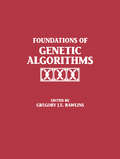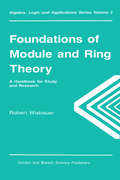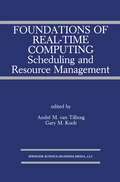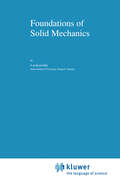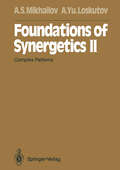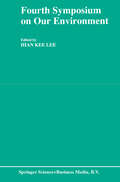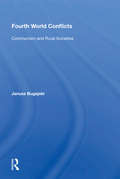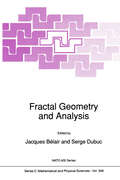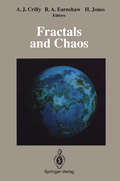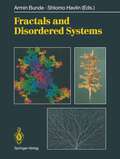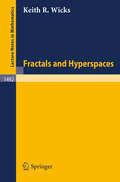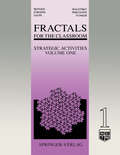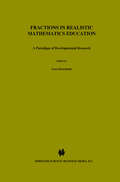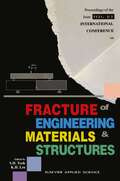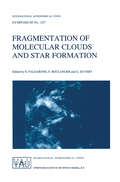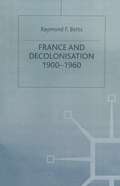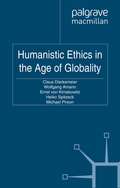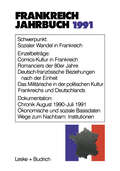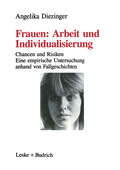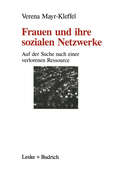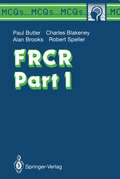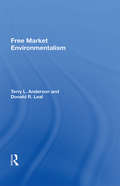- Table View
- List View
Foundations of Genetic Algorithms 1991 (ISSN #Volume 1)
by FogaFoundations of Genetic Algorithms 1991 (FOGA 1) discusses the theoretical foundations of genetic algorithms (GA) and classifier systems. This book compiles research papers on selection and convergence, coding and representation, problem hardness, deception, classifier system design, variation and recombination, parallelization, and population divergence. Other topics include the non-uniform Walsh-schema transform; spurious correlations and premature convergence in genetic algorithms; and variable default hierarchy separation in a classifier system. The grammar-based genetic algorithm; conditions for implicit parallelism; and analysis of multi-point crossover are also elaborated. This text likewise covers the genetic algorithms for real parameter optimization and isomorphisms of genetic algorithms. This publication is a good reference for students and researchers interested in genetic algorithms.
Foundations of Module and Ring Theory: A Handbook For Study And Research (Algebra, Logic And Applications Ser.)
by Robert WisbauerThis volume provides a comprehensive introduction to module theory and the related part of ring theory, including original results as well as the most recent work. It is a useful and stimulating study for those new to the subject as well as for researchers and serves as a reference volume. Starting form a basic understanding of linear algebra, the theory is presented and accompanied by complete proofs. For a module M, the smallest Grothendieck category containing it is denoted by o[M] and module theory is developed in this category. Developing the techniques in o[M] is no more complicated than in full module categories and the higher generality yields significant advantages: for example, module theory may be developed for rings without units and also for non-associative rings. Numerous exercises are included in this volume to give further insight into the topics covered and to draw attention to related results in the literature.
Foundations of Module and Ring Theory
by Robert WisbauerThis volume provides a comprehensive introduction to module theory and the related part of ring theory, including original results as well as the most recent work. It is a useful and stimulating study for those new to the subject as well as for researchers and serves as a reference volume. Starting form a basic understanding of linear algebra, the theory is presented and accompanied by complete proofs. For a module M, the smallest Grothendieck category containing it is denoted by o[M] and module theory is developed in this category. Developing the techniques in o[M] is no more complicated than in full module categories and the higher generality yields significant advantages: for example, module theory may be developed for rings without units and also for non-associative rings. Numerous exercises are included in this volume to give further insight into the topics covered and to draw attention to related results in the literature.
Foundations of Real-Time Computing: Scheduling and Resource Management (The Springer International Series in Engineering and Computer Science #141)
by André M. Van Tilborg Gary M. KoobThis volume contains a selection of papers that focus on the state-of the-art in real-time scheduling and resource management. Preliminary versions of these papers were presented at a workshop on the foundations of real-time computing sponsored by the Office of Naval Research in October, 1990 in Washington, D.C. A companion volume by the title Foundations of Real-Time Computing: Fonnal Specifications and Methods complements this book by addressing many of the most advanced approaches currently being investigated in the arena of formal specification and verification of real-time systems. Together, these two texts provide a comprehensive snapshot of current insights into the process of designing and building real-time computing systems on a scientific basis. Many of the papers in this book take care to define the notion of real-time system precisely, because it is often easy to misunderstand what is meant by that term. Different communities of researchers variously use the term real-time to refer to either very fast computing, or immediate on-line data acquisition, or deadline-driven computing. This text is concerned with the very difficult problems of scheduling tasks and resource management in computer systems whose performance is inextricably fused with the achievement of deadlines. Such systems have been enabled for a rapidly increasing set of diverse end-uses by the unremitting advances in computing power per constant-dollar cost and per constant-unit-volume of space. End-use applications of deadline-driven real-time computers span a spectrum that includes transportation systems, robotics and manufacturing, aerospace and defense, industrial process control, and telecommunications.
Foundations of Solid Mechanics (Solid Mechanics and Its Applications #3)
by P. KarasudhiThis book has been written with two purposes, as a textbook for engineering courses and as a reference book for engineers and scientists. The book is an outcome of several lecture courses. These include lectures given to graduate students at the Asian Institute of Technology for several years, a course on elasticity for University of Tokyo graduate students in the spring of 1979, and courses on elasticity, viscoelasticity and ftnite deformation at the National University of Singapore from May to November 1985. In preparing this book, I kept three objectives in mind: ftrst, to provide sound fundamental knowledge of solid mechanics in the simplest language possible; second, to introduce effective analytical and numerical solution methods; and third, to impress on readers that the subject is beautiful, and is accessible to those with only a standard mathematical background. In order to meet those objectives, the ftrst chapter of the book is a review of mathematical foundations intended for anyone whose background is an elementary knowledge of differential calculus, scalars and vectors, and Newton's laws of motion. Cartesian tensors are introduced carefully. From then on, only Cartesian tensors in the indicial notation, with subscript as indices, are used to derive and represent all theories.
Foundations of Synergetics II: Complex Patterns (Springer Series in Synergetics #52)
by Alexander S. Mikhailov Alexander Yu. LoskutovThis textbook is based on a lecture course in synergetics given at the University of Moscow. In this second of two volumes, we discuss the emergence and properties of complex chaotic patterns in distributed active systems. Such patterns can be produced autonomously by a system, or can result from selective amplification of fluctuations caused by external weak noise. Although the material in this book is often described by refined mathematical theories, we have tried to avoid a formal mathematical style. Instead of rigorous proofs, the reader will usually be offered only "demonstrations" (the term used by Prof. V. I. Arnold) to encourage intuitive understanding of a problem and to explain why a particular statement seems plausible. We also refrained from detailing concrete applications in physics or in other scientific fields, so that the book can be used by students of different disciplines. While preparing the lecture course and producing this book, we had intensive discussions with and asked the advice of Prof. V. I. Arnold, Prof. S. Grossmann, Prof. H. Haken, Prof. Yu. L. Klimontovich, Prof. R. L. Stratonovich and Prof. Ya.
Fourth Symposium on our Environment: Proceedings of the Fourth Symposium on Our Environment, held in Singapore, May 21–23, 1990
by Hian Kee Hian Kee LeeProceedings of the Fourth Symposium on Our Environment, held in Singapore, May 21-23, 1990
Fourth World Conflicts: Communism And Rural Societies
by Janusz BugajskiThis study consists of a comprehensive examination of Communist policies toward rural populations and indigenous societies in a cross-section of developing Third World states. It explores the universal threads and national adaptations of Communist or Marxist-Leninist theory and praxis.
Fourth World Conflicts: Communism And Rural Societies
by Janusz BugajskiThis study consists of a comprehensive examination of Communist policies toward rural populations and indigenous societies in a cross-section of developing Third World states. It explores the universal threads and national adaptations of Communist or Marxist-Leninist theory and praxis.
Fractal Geometry and Analysis (Nato Science Series C: #346)
by Jacques Bélair Serge DubucThis ASI- which was also the 28th session of the Seminaire de mathematiques superieures of the Universite de Montreal - was devoted to Fractal Geometry and Analysis. The present volume is the fruit of the work of this Advanced Study Institute. We were fortunate to have with us Prof. Benoit Mandelbrot - the creator of numerous concepts in Fractal Geometry - who gave a series of lectures on multifractals, iteration of analytic functions, and various kinds of fractal stochastic processes. Different foundational contributions for Fractal Geometry like measure theory, dy namical systems, iteration theory, branching processes are recognized. The geometry of fractal sets and the analytical tools used to investigate them provide a unifying theme of this book. The main topics that are covered are then as follows. Dimension Theory. Many definitions of fractional dimension have been proposed, all of which coincide on "regular" objects, but often take different values for a given fractal set. There is ample discussion on piecewise estimates yielding actual values for the most common dimensions (Hausdorff, box-counting and packing dimensions). The dimension theory is mainly discussed by Mendes-France, Bedford, Falconer, Tricot and Rata. Construction of fractal sets. Scale in variance is a fundamental property of fractal sets.
Fractals and Chaos
by A. J. Crilly Rae Earnshaw Huw JonesThis volume is based upon the presentations made at an international conference in London on the subject of 'Fractals and Chaos'. The objective of the conference was to bring together some of the leading practitioners and exponents in the overlapping fields of fractal geometry and chaos theory, with a view to exploring some of the relationships between the two domains. Based on this initial conference and subsequent exchanges between the editors and the authors, revised and updated papers were produced. These papers are contained in the present volume. We thank all those who contributed to this effort by way of planning and organisation, and also all those who helped in the production of this volume. In particular, we wish to express our appreciation to Gerhard Rossbach, Computer Science Editor, Craig Van Dyck, Production Director, and Nancy A. Rogers, who did the typesetting. A. J. Crilly R. A. Earnshaw H. Jones 1 March 1990 Introduction Fractals and Chaos The word 'fractal' was coined by Benoit Mandelbrot in the late 1970s, but objects now defined as fractal in form have been known to artists and mathematicians for centuries. Mandelbrot's definition-"a set whose Hausdorff dimension is not an integer" -is clear in mathematical terms. In addition, related concepts are those of self-similarity and sub-divisibility. A fractal object is self-similar in that subsections of the object are similar in some sense to the whole object.
Fractals and Disordered Systems
by Armin Bunde Shlomo HavlinFractals and disordered systems have recently become the focus of intense interest in research. This book discusses in great detail the effects of disorder on mesoscopic scales (fractures, aggregates, colloids, surfaces and interfaces, glasses, and polymers) and presents tools to describe them in mathematical language. A substantial part is devoted to the development of scaling theories based on fractal concepts. In 10 chapters written by leading experts in the field, including E. Stanley and B. Mandelbrot, the reader is introduced to basic concepts and techniques in disordered systems and is lead to the forefront of current research. In each chapter the connection between theory and experiment is emphasized, and a special chapter entitled "Fractals and Experiments" presents experimental studies of fractal systems in the laboratory. The book is written pedagogically. It can be used as a textbook for graduate students, by university teachers to prepare courses and seminars, and by active scientists who want to become familiar with a fascinating new field.
Fractals and Hyperspaces (Lecture Notes in Mathematics #1492)
by Keith R. WicksAddressed to all readers with an interest in fractals, hyperspaces, fixed-point theory, tilings and nonstandard analysis, this book presents its subject in an original and accessible way complete with many figures. The first part of the book develops certain hyperspace theory concerning the Hausdorff metric and the Vietoris topology, as a foundation for what follows on self-similarity and fractality. A major feature is that nonstandard analysis is used to obtain new proofs of some known results much more slickly than before. The theory of J.E. Hutchinson's invariant sets (sets composed of smaller images of themselves) is developed, with a study of when such a set is tiled by its images and a classification of many invariant sets as either regular or residual. The last and most original part of the book introduces the notion of a "view" as part of a framework for studying the structure of sets within a given space. This leads to new, elegant concepts (defined purely topologically) of self-similarity and fractality: in particular, the author shows that many invariant sets are "visually fractal", i.e. have infinite detail in a certain sense. These ideas have considerable scope for further development, and a list of problems and lines of research is included.
Fractals for the Classroom: Strategic Activities Volume One
by Heinz-Otto Peitgen Hartmut Jürgens Dietmar Saupe Evan Maletsky Terry Perciante Lee YunkerThere are many reasons for writing this first volume of strategic activities on fractals. The most pervasive is the compelling desire to provide students of mathematics with a set of accessible, hands-on experiences with fractals and their underlying mathematical principles and characteristics. Another is to show how fractals connect to many different aspects of mathematics and how the study of fractals can bring these ideas together. A third is to share the beauty of their structure and shape both through what the eye sees and what the mind visualizes. Fractals have captured the attention, enthusiasm, and interest of many people around the world. To the casual observer, their color, beauty, and geometric structure captivates the visual senses like few other things they have ever experienced in mathematics. To the computer scientist, fractals offer a rich environment in which to explore, create, and build a new visual world as an artist creating a new work. To the student, fractals bring mathematics out of past history and into the twenty-first century. To the mathematics teacher, fractals offer a unique, new opportunity to illustrate both the dynamics of mathematics and its many connecting links.
Fractions in Realistic Mathematics Education: A Paradigm of Developmental Research (Mathematics Education Library #8)
by Leen StreeflandFracture of Engineering Materials and Structures
by S. H. Teoh K. H. LeeRecent advances in the field of fracture of engineering materials and structures have increasingly indicated its multidisciplinary nature. This area of research now involves scientists and engineers who work in materials science, applied mathematics and mechanics, and also computer scientists. The present volume, which contains the Proceedings of the Joint FEFG/lCF International Conference on Fracture of Engineering Materials and Structures held in Singapore from the 6th to 8th of August 1991, is a testimony of this multidisciplinary nature. This International Conference was the Second Symposium of the Far East Fracture Group (FEFG) and thus provided a unique opportunity for researchers and engineers in the Far East region to exchange and acquire knowledge of new advances and applications in fracture. The Conference was also the Inter-Quadrennial International Conference on Fracture (ICF) for 1991 and thus appealed to researchers in the international arena who wished to take advantage of this meeting to present their findings. The Conference has brought together over 130 participants from more than 24 countries, and they represented government and industrial research laboratories as well as academic institutions. It has thus achieved its objective of bringing together scientists and engineers with different backgrounds and perspectives but with . a common interest in new developments in the fracture of engineering materials and structures. This volume contains 4 keynote papers, 4 invited papers and 130 contributed papers.
Fragmentation of Molecular Clouds and Star Formation: Proceedings of the 147th Symposium of the International Astronomical Union, Held in Grenoble, France, June 12–16, 1990 (International Astronomical Union Symposia #147)
by E. Falgarone F. Boulanger G. DuvertA few years ago, a motivation for organizing one more IAU Symposium on star for mation in Grenoble, was the anticipated completion of the IRAM interferometer on the Plateau de Bures, close to Grenoble. This choice was also a sort of late celebration of the genius of Joseph Fourier, born in Grenoble, whose work is the very fondation of in terferometry. At the time when we finally announced the advent of this conference, the first reactions we got from the community were expressions of saturation and even reject, the Symposium being unfortunately scheduled almost simultaneously as two other major meetings on closely related topics, and sponsored by different organizations. A wave of disappointment then reached the organizers. Some of us were enthusiastic enough to help the others overcome their discouragement. Let them be thanked here. There was, indeed, a deeper motivation for organizing this conference. It was to trigger the meeting and communication of physicists and astrophysicists since many of the difficulties met now in understanding the physics of the interstellar medium and its evolution toward star formation are common to several, if not most, other fields of physics. They are assigned to one origin: complexity.
France and Decolonisation (The Making of the Twentieth Century)
by Raymond BettsBy 1914 France had amassed over ten million square kilometres, and 60 million people including the colonies of Algeria, Tunisia, Morocco, the colony in S.E. Asia known as Indochina and a vast block of West Africa. This study gives the undergraduate student a factual geographical and historical background to the establishment of the early twentieth century French colonial empire. The author describes in detail the physical struggles between the colonies and their rules and the subsequent demise of the Empire.
France and the Mass Media (Warwick Studies in the European Humanities)
by Nicholas Hewitt Brian RigbyIn this volume specialists from Britain and France adopt a fresh approach to the study of French culture since 1945 by focusing on the mass media and on a whole range of popular cultural forms. As well as introducing English-speaking readers to such new fields as French radio, television, science fiction and popular song, this volume also highlights how the French themselves responded to the growing importance of the mass media in postwar France.
Frankreich-Jahrbuch 1991: Politik, Wirtschaft, Gesellschaft, Geschichte, Kultur
by Deutsch-Französisches InstitutFrauen: Chancen und Risiken. Eine empirische Untersuchung anhand von Fallgeschichten
by Angelika DiezingerFrauen und ihre sozialen Netzwerke: Auf der Suche nach einer verlorenen Ressource
by Verena Mayr-KleffelFRCR Part I (MCQ's...Brainscan)
by Paul Butler Charles G. Blakeney Alan Brooks Robert Speller9th volume to be published in this successful series of re- vision / study aids, FRCR Part 1 is derived from the questions used in the annual revision course held at The Royal London and St. Bartholomew's hospitals.
Free Market/spec Sale/avail Hard Only
by Terry L. AndersonAlthough there is in the United States a clear national consensus supporting the protection of the environment, advocates often profoundly disagree about the policies best designed to achieve this end. The traditional answer has been that government must intervene, through legislation and regulation of behavior, to preserve environmental values. Th
Free Market/spec Sale/avail Hard Only
by Terry L. AndersonAlthough there is in the United States a clear national consensus supporting the protection of the environment, advocates often profoundly disagree about the policies best designed to achieve this end. The traditional answer has been that government must intervene, through legislation and regulation of behavior, to preserve environmental values. Th
